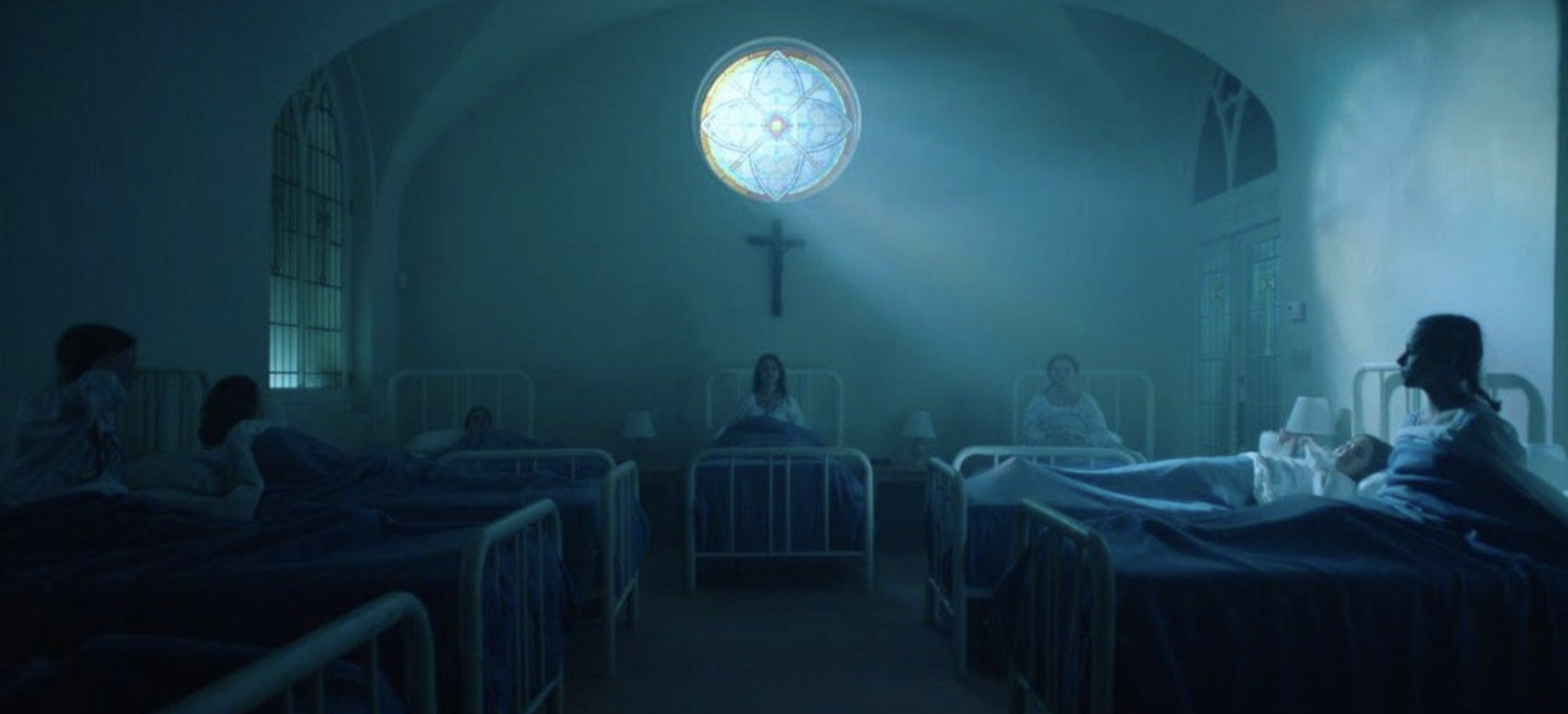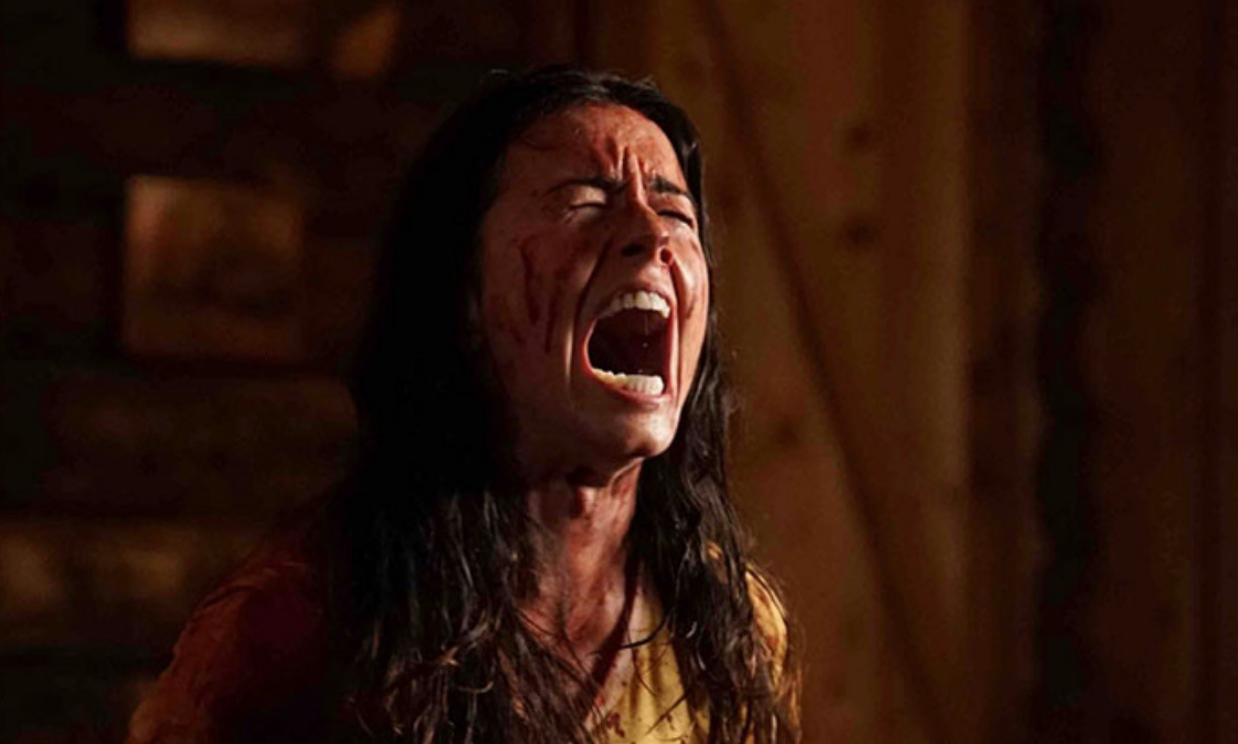 NIGHTMARE CINEMA
NIGHTMARE CINEMA
Starring: Eric Nelsen, Sarah Withers, Kevin Fonteyne, Chris Warren | Richard Chamberlain, Zarah Mahler, Mark Grossman, Maurice Benard, Stephanie Cood, Calista Bess, Mariela Garriga, Elizabeth Reaser, Adam Godley, Ezra Buzzington, Bronwyn Merrill, Patrick Wilson, Faly Rakotohavana, Annabeth Gish, Daryl C. Brown, Lexy Panterra, and Orson Chaplin
Directed by: Alejandro Brugués, Joe Dante, Mick Garris, Ryūhei Kitamura, and David Slade
Written by: Sandra Becerril, Alejandro Brugués, Lawrence C. Connolly, Mick Garris, Richard Christian Matheson, and David Slade
Horror anthology films are a tricky order. Every one ever made feels uneven. The quality of the stories is never perfectly consistent (especially if each segment is handled by a different creative team). No matter how many more stories they may have than a traditional singular narrative, in many ways, they feel locked into a structure so time-tested and predictable that even a novice horror fan can recognize it. A frame narrative is introduced, said frame narrative provides smooth transitions into the individual stories. When the stories are finished, the frame narrative itself is closed out — almost always with a twist that sees the characters in the frame narrative doomed in their own right.
From Amicus’s 1972 adaptation of Tales from the Crypt through the VHS films, almost every horror anthology I have seen and can remember adheres to this basic arrangement. Because they are so similar structurally, there are only a few ways to make one stand apart from others. One needs either a strong stylistic or thematic identity (like Creepshow, which so memorably recreated the garish colors and exaggerated visuals of the EC horror comics it drew influence from), or a clever or unusual framing device (like the cache of tapes in VHS or Cat’s Eye, in which the stories are connected by a stray cat’s wanderings) to make their anthology film really pop and stick out from others.
When it comes to the latter, Nightmare Cinema could have done a lot worse. It sets the anthology in a spooky movie theater, where any hapless passerby finding themselves mysteriously drawn in witnesses their worst nightmare. It fits the classic mold of this kind of film while still having a fighting chance of forging its own identity. When it comes to a stylistic or thematic identity, it fares much more poorly. Nightmare Cinema’s segments are each handled by different directors, which means the peaks-and-valleys of quality so common in anthology films are even more extreme. Unfortunately, with few exceptions, the majority of these tales live up to the title in the worst possible sense.
With these kinds of films, it is often wise to save the best for last, so as not to peak at the very beginning. Nightmare Cinema has ambitions of pursuing this tactic, which would be great if the segments were, at worst, good. Sadly, that is not the case here. We’re left with a film frontloaded with its worst offerings. They get the worst over with first, which, on paper, sounds like a reasonable strategy, but Alejandro Brugués’s The Thing in the Woods is so hollow and awful that I could imagine it convincing prospective viewers to give up on the whole movie. It attempts to be some twist on the slasher film formula.
Still, its characters and sequences are so achingly superficial and uninvolving that it is basically impossible to see it as anything other than pointless. I’m being honest when I say that, aside from a somewhat clever variation on the classic “monster POV” shot, the highlight of the segment is one of the characters speaking the ridiculous line “Fuck science.” It’s a dismal and tedious affair, and while I hate how generally condescending the word “amateurish” can seem, it’s a descriptor this portion richly deserves.

The second tale, Joe Dante’s Mirare, is an immediate step-up from The Thing in the Woods just by having the suggestion of something resembling story and character, but ultimately is fairly hum-drum and tepid in its execution. A woman with a facial scar seeks the aid of a plastic surgeon. Things predictably go horribly wrong, and I mean predictably.
The medical field and plastic surgery specifically is a treasure trove for body horror. One that provides all manner of ways to naturally prey on an audience’s natural discomfort with their own flesh and the level of trust we must place in medical professionals (or perhaps “professionals”). This story never moves past a horizon line that was obvious and plainly visible from the outset. Besides a fun, smarmy performance from Richard Chamberlain — clearly an amusing allusion to the actor’s tenure as Dr. Kildare – there is little of the irreverent wit and fun ingenuity that marks Dante’s best offerings. It never outsteps its immediate forecast and just kind of jogs in place until it’s over.
From there, we move onto Ryūhei Kitamura’s Mashit, the utterly ridiculous tale of a perverse demon terrorizing a congregation of Catholic schoolchildren and their guardians. This segment seems to lean somewhat intentionally into the tacky and ludicrous, which won’t surprise anyone who has seen Kitamura’s Versus. The characters and story are so empty of all but the most obvious and direct purpose that even its insanity amounts to little more than tedium.

The moments of potential humor and potential horror are hampered by the segment’s inability to decide what it really is. The heft of the whole thing is so lifeless that it never gets close to accomplishing either. However, while it ends in a way that you’ve seen a million things end, one absurd sequence in the finale definitely had me smirking at its sheer lunacy. That’s more than I can say for The Thing in the Woods.
At this point, I was starting to think the entire anthology might be a wash, but then in strolls David Slade and his segment This Way to Egress to save the movie. Easily the best the film has to offer, this genuinely disquieting story of a woman who finds the world around her altering horrifically as she waits for a doctor’s appointment packs into its duration a genuinely memorable atmosphere and the lingering impact that the preceding segments were so lacking.
It’s the first (and only) of the stories to actually — get this — feel like a nightmare. Slade makes phenomenal use of his limited resources to create warped visuals that are as unsettling as they are crude. Just as significantly, our investment in the piece is anchored by our lead character (performed effectively by Elizabeth Reaser). She inspires empathy and genuine interest in a way that the other segments’ casts do not. It’s a wonderful piece of work and seems like it should be part of another, much stronger film.
The quality of the final segment, Mick Garris’s Dead, feels a bit like the mean average of the preceding segments’ quality. It pales in comparison to its immediate predecessor but is much more functional and competent than the first three stories. The plot, concerning an adolescent who can see spirits after being revived from death, is exactly the kind of story you would expect to see on a Twilight Zone-style anthology TV show and sticks exclusively to the tried-and-true. But what it lacks in originality, it makes up for in basic efficiency.
Aside from a very silly slasher-style plotline that derails a fair portion of the ending, Dead is sturdy if nothing revolutionary. Like This Way to Egress, it shows that just having characters who have something — ANYTHING — to them goes an extremely long way toward avoiding the emptiness that plagues most of the film.

The frame narrative filling in the gaps between the segments and capping off the ending, The Projectionist (also directed by Garris), is nothing if not traditional and, by the end, has made a stronger case for itself than one might imagine. Our first glimpses of the framing device and Mickey Rourke’s characteristically craggy titular figure are harmlessly ineffective.
By the ending, I had found myself warmed to it and Rourke’s perfectly sketchy aura. It doesn’t venture beyond what one would expect from the traditional anthology structure. However, it does its job and has fun doing it. If only more of the segments could say the same. Hell, if Rourke’s Projectionist invited me to another outing at the Nightmare Cinema with segments that were all as effective and memorable as Slade’s, I’d happily buy myself a ticket. As things stand in this film, though, the guy needs work on his curating.


